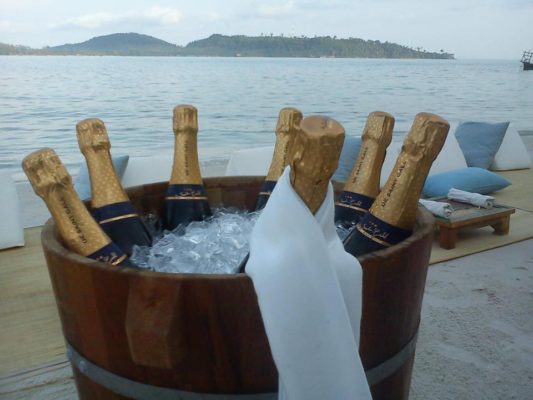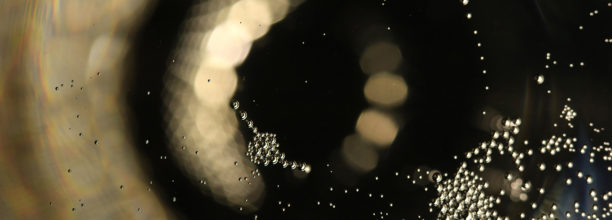
Effervescence or “bubbles” in wine has been around for a long time and recorded by the ancient Greeks and Romans. But the cause of the bubbles was unknown, attributed to phases of the moon or good and evil spirits. However, in 1622 Dr. Francesco Sacchi published the first historical reference to the production of sparkling wine and 40 years later Christopher Merret presented the Royal Society of London with the first known paper detailing the science behind the production of sparkling wine.
Champagne is the most famous sparkling wine. From its fine bead of bubbles to its creamy mousse and complexity, it is the drink of celebration, elegance and fun. It is also a trademark worn only by wines made in the Champagne region of France, which is where the phenomenon of re-fermentation in the bottle commonly occurred.
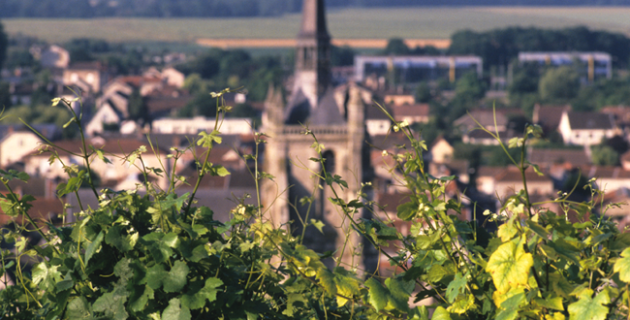
Initially it was seen as something of a fault of the basic winemaking techniques of the time and the storage and climatic conditions in the region. Weak and unstable “wood-fired” glass meant that this naturally occurring process would wreak havoc in the cellars of the Champenoise when bottles would often explode en masse at any minor disruption, causing horrific eye injuries to workers who took to wearing large, heavy iron masks in the cellars.
Often, the explosion of one bottle would set of a chain of eruptions with producers recording stock losses of 20%-90% of their bottles. Which is where Dom Pierre Pérignon, the Benedictine monk comes into the picture after he moved to the abbey of Hautvillers, near Epernay, in 1668.
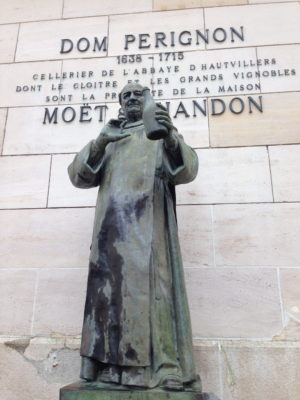
He was charged with and succeeded in improving winemaking and grape growing in the region, including addressing the problem of re-fermentation in the bottle. In his time, secondary bottle fermentation was an enormous problem. When cool autumn weather set in, primary fermentation would often cease, preventing fruit sugars in the wine from fermenting out and converting to alcohol. If the wine was bottled in this condition, it became a literal time bomb. Dom Perignon was charged addressing the problem of re-fermentation, which he did.
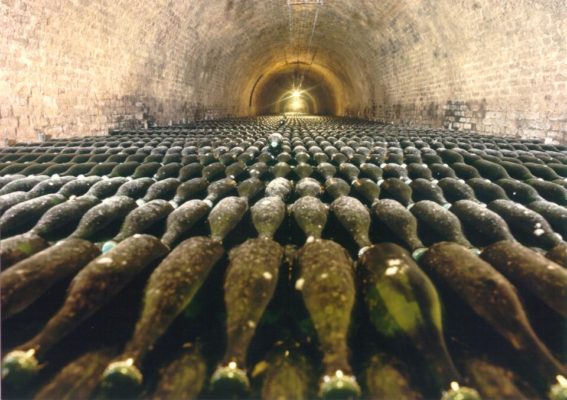
However, it’s to the English not the French that we must look to for Champagne’s popularity. It was not only their love of the fizz; it was also their scientific and technological advances in glass and bottle making which ensured its sustainable production and the survival of sparkling as a wine style.
Sir Robert Mansell who obtained a monopoly on glass manufacture in Great Britain in 1615 through his patent on using the coal fires in Newcastle which he found produced a much stronger glass.
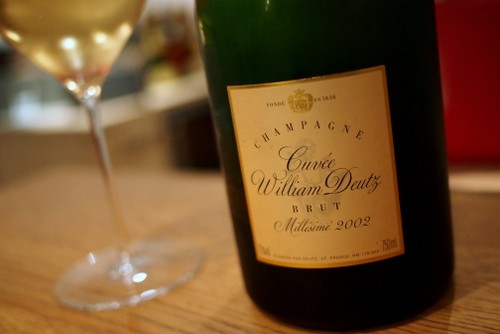
In England the bottles were popular in stabilizing sparkling cider and as the Champenoise began to eliminate the secondary fermentation in their wines, the English began complaining that they wanted the bubbles ‘ put back in’. Eventually, with the help of the stronger British glass bottles the Champenoise yielded to the demands of their largest client, England.
Today, with its fine bead, creamy mousse and heady aromas of truffles, brioche and nuts it is the drink of kings and queens, the rich and famous, newlyweds, launch parties, horse races, winner’s podiums and New Years and for connoisseurs it is simple one of life’s great pleasures, like drinking ‘the stars in your glass’, Merry Christmas and a Happy New Year; enjoy.
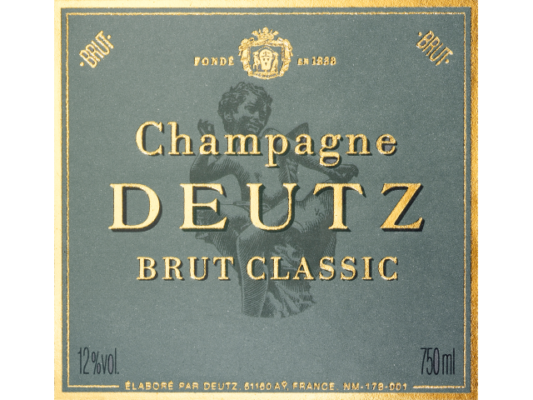
The noble fizz starts out as a still wine made from chardonnay, pinot noir and pinot meunier grapes either together or alone. These are harvested at optimum ripeness for sparkling wine production, which tends to have lower sugar and higher acidity levels than grapes harvested for the production of other wine styles. A gentle pressing then ensures nothing is picked up from the skins and only the purest juice is used to make the wine, which is then fermented in tanks in much the same way as table wine. The resultant liquid is high in acid, sharp and unpleasant to drink.
The next stage is the assembling of the various base wines to produce the desired blend, which is transferred to bottles where yeast and sugars are added to promote secondary fermentation. This is where, fermenting under pressure, the bubbles are formed and trapped in solution. After secondary fermentation, the wine is given time – between 18 months and six to eight years – on its yeast lees to pick up additional flavour and complexity.
The yeast cells are then gently moved into the neck of the bottle where they are frozen and then blown off or “gushed”, a process where the bottle is opened and the ice-trapped yeast cells explode out of the top. Finally, a dosage of liqueur is added to top up the Champagne with the level of sweetness adjusted depending on the style of Champagne to be produced. Most of the Champagne produced today is Non-vintage, meaning that it is a blended product of grapes from multiple vintages.
Most of the base will be from a single year vintage with producers blending anywhere from 10%–15% (even as high as 40%) of wine from older vintages.
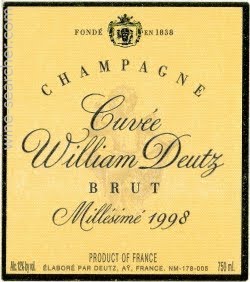
Vintage
If the conditions of a particular vintage are favourable, some producers will make a “vintage” wine that must be composed of at least 85% of the grapes from a vintage year. Under Champagne wine regulations, houses that make vintage and non-vintage wines are allowed to use no more than 80% of the total vintage’s harvest for the production of vintage Champagne.
This allows at least 20% of the harvest from each vintage to be reserved for use in non-vintage Champagne. This ensures a consistent style that consumers can expect from non-vintage Champagne that does not alter too radically depending on the quality of the vintage. In less than ideal vintages, some producers will make a wine from only that single vintage and still label it as non-vintage rather than as “vintage”, since the wine will be of a lesser quality.
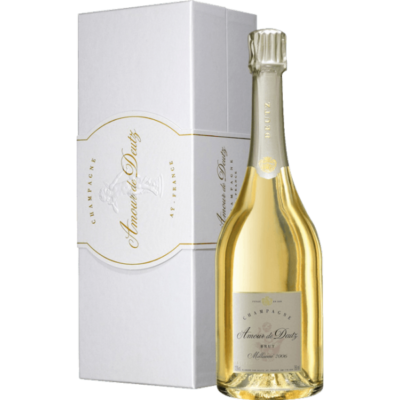
Prestige Cuvee
A cuvée de prestige is proprietary blended Champagne that is considered to be the top of a producer’s range. Famous examples include Louis Roederer Cristal, Laurent-Perrier Grand Siècle, Moët & Chandon Dom Pérignon, Duval-Leroy Cuvée Femme and Pol Roger Cuvée Sir Winston Churchill. Perhaps the original prestige cuvée was Moët’s Dom Pérignon, which launched in 1936 with the 1921 vintage.
Until then Champagne houses produced different cuvées of varying quality, but a top-of-the-range wine produced to the highest standards (and priced accordingly) was a new idea. In fact, Louis Roederer had been producing Cristal since 1876, but this was strictly for the private consumption of the Russian tsar. Cristal was made publicly available with the 1945 vintage. Then came Taittinger’s Comtes de Champagne (first vintage 1952), and Laurent-Perrier Grand Siècle La Cuvée in 1960, which was a blend of three vintages (1952, 1953, and 1955) and Perrier Jouet La Belle Époque.
In the last three decades of the 20th century, most Champagne houses followed these with their own prestige cuvées, often named after notable people with a link to that producer and presented in non-standard bottle shapes (following Dom Pérignon’s lead with its 18th century revival design).
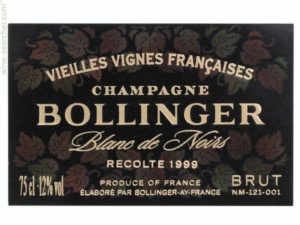
Blanc de noirs
This is a French term (literally “white from black” or “white of blacks”) for a white wine produced from black or red grapes. They have a white flesh and the juice obtained from them after minimal possible contact with the skins produces white wine, the colour of which is offset by the small amount of red skin pigments. It turns into lighter shades of yellow, often described as white-yellow, white-grey, or silvery and is often found in Champagne, where a number of houses have followed the lead of Bollinger’s prestige cuvée Vieilles Vignes Françaises in introducing a cuvée made from either pinot noir, pinot meunier or a blend of the two (these being the only two black grapes permitted within Champagne).
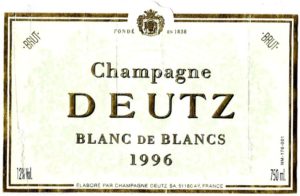
Blanc de blancs
Meaning white from whites, it is used to designate Champagnes made exclusively from chardonnay grapes or in rare occasions from pinot blanc (such as La Bolorée from Cédric Bouchard). A famous example is Ruinart. The term is occasionally used in other sparkling wine-producing regions, usually to denote chardonnay-only wines rather than any sparkling wine made from other white grape varieties.
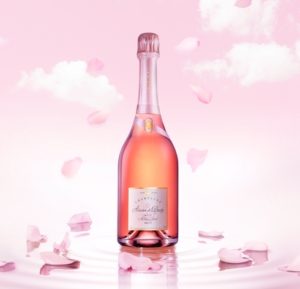
Rosé Champagne
The rosé wines of Champagne (also known as pink Champagne) are produced either by leaving the clear juice of black grapes to macerate on the skins for a brief time (known as the saigneé method) or, more commonly, by adding a small amount of still pinot noir red wine to the sparkling wine cuvée. Champagne is typically light in colour even if it is
Champagne Bottle Sizes
Bottle name, Volume Equivalent in Standard Bottles, Derivation of bottle name:
1 Piccolo: 187ml
2 Half Bottle: 375ml
3 Standard Bottle: 750ml, 1 bottle
4 Magnum: 1.5 litres, 2 bottles
5 Jeroboam: 3 litres, 4 bottles, founder and first king of Israel, 931-910BC
6 Rehoboam: 4.5 litres, 6 bottles, son of Solomon, king of Judah, 922-908BC
7 Methuselah: 6 litres, 8 bottles, biblical patriarch who lived to the age of 969
8 Salmanazar: 9 litres, 12 bottles, King of Assyria, 859-824BC
9 Balthazar: 12 litres, 16 bottles, regent of Babylon, son of Nabonide, 539BC
10 Nebuchadnezzar: 15 litres, 20 bottles, king of Babylon, 605-562BC
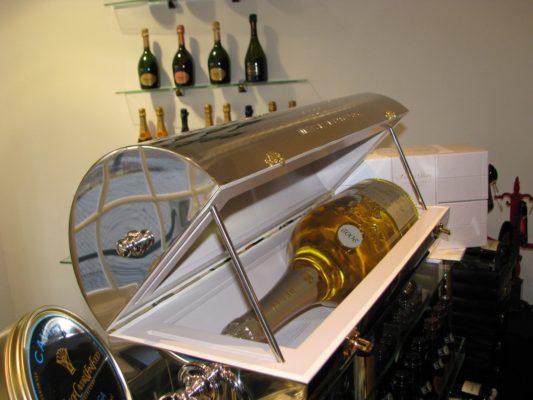
FRENCH SPARKLING WINES PRODUCED OUTSIDE CHAMPAGNE
Crémant
Sparkling wines designated crémant, or creamy, were originally named because their lower carbon dioxide pressures were thought to give them a creamy rather than fizzy mouth-feel. Though they may have full pressures today, they are still produced using the traditional method, and have to fulfill strict production criteria. In France there are seven appellations for sparkling wine, which include the designation crémant in their name:
- Crémant d’Alsace
- Crémant de Bordeaux
- Crémant de Bourgogne
- Crémant de Die
- Crémant du Jura
- Crémant de Limoux
- Crémant de Loire
Other French sparkling wines
There are other French appellations for sparkling wines. Some are exclusively sparkling wine appellations; others are appellations allowing both still and sparkling wine to be made. The term Mousseux is French for “sparkling” and can refer to a sparkling wine made using methods other than the méthode champenoise such as the charmat method, while crémant can only be used for wines that have been made using the méthode champenoise.
Sparkling-only:
- Anjou mousseux AOC
- Blanquette de Limoux AOC
- Blanquette méthode ancestrale AOC
- Bourgogne mousseux AOC
- Clairette de Die AOC
- Saumur mousseux AOC
- Touraine mousseux AOC
Either still or sparkling:
- Gaillac AOC
- Saint-Péray AOC
- Vouvray AOC
- Montlouis AOC
Other Techniques for the production of sparkling wine
The Charmat Process
The Charmat process is known as Metodo Charmat-Martinotti (or Metodo Martinotti) in Italy, where it was invented and is most used. The wine undergoes secondary fermentation in stainless steel tanks or steel vessels covered with vitreous enamel rather than individual bottles, and are bottled under pressure in a continuous process. Many grape varieties, including prosecco, are best suited for fermentation in tanks. Charmat-method sparkling wines can be produced at a slightly lower cost than méthode champenoise wines.
Transfer Method
This follows the first steps of méthode champenoise in that after primary fermentation the cuvée is transferred to bottles to complete secondary fermentation. When the secondary fermentation is complete and the wine has spent the desired amount of time in bottle on yeast lees (six months is the requirement to label a wine bottle fermented) then the individual bottles are transferred (hence the name) into a larger tank. The wine is then filtered, the liqueur de dosage added and then put back into new bottles for sale. This method allows for complexity to be built into the wine, but also gives scope for blending options after the wine has gone into bottle and reduces the bottle-to-bottle variations that can be hard to control in the méthode champenoise. A criticism of this method is that the filtration process can strip the wine of flavours and complexity.
Injection Method
Comparatively inexpensive sparkling wine is made by simple injection of CO2 from a carbonator. This way of manufacturing is allowed in the European Union. Sparkling wines made via this method must use terms such as “aerated sparkling wine” and “aerated semi-sparkling wine” and be supplemented, where necessary, by the words “obtained by adding carbon dioxide” or “obtained by adding carbon anhydride”.
OTHER SPARKLING WINES FROM AROUND THE WORLD
Cava
Cava is the name of a type of Spanish white or pink sparkling wine produced mainly in the Penedès region in Catalonia, 40km southwest of Barcelona and was created in 1872 by Joseph Raventós.
The vineyards of Penedès were devastated by phylloxera, and the predominantly red vines were being replaced by large numbers of white grape vines. After seeing the success of the Champagne region, Raventós decided to create the dry sparkling wine that has become the reason for the region’s continued success.
Cava is produced in varying levels of dryness of the wine which are: brut nature, brut (extra dry), sec (in Catalan) seco (dry), semisec (in Catalan) semiseco (medium) and dolç (in Catalan) dulce (sweet). Under Spanish Denominación de Origen laws, cava can be produced in six wine regions and must be made according to the traditional method with second fermentation in the bottle and uses a selection of the grapes macabeo, parellada, xarelo, chardonnay, pinot noir and subirat. Despite being a traditional Champagne grape, chardonnay was not used in the production of cava until the 1980s.
Italian Sparkling Wine
Spumante (foaming) is a general and common term (although, not the only one) used to describe sparkling Italian wine.
According to etymological sources, the term was not used in a wine context until 1908, more than 40 years after the first Italian sparkling wine using the méthode champenoise was produced by Carlo Gancia and sold as “Moscato Champagne”.
Sparkling wines are made throughout Italy, but the Italian sparklers most widely seen on the world market are the Franciacorta from Lombardy, asti from Piedmont, lambrusco from Emilia and prosecco from Veneto. The Trento DOC is also famous for sparkling wine.
Though Franciacorta wines are made according to the traditional method, most Italian sparkling wines, in particular asti and prosecco, are made with the charmat method. Asti is a slightly sweet sparkler made from the moscato grape in the province of Asti. The wine is noted for its low alcohol levels around 8% and fresh, grapey flavours.
Moscato d’Asti is a frizzante-style slightly sparkling version of asti; it is sweeter and contains even less alcohol, typically around 5.5%. The Franciacorta region, located northwest of Brescia, is home to the largest segment of Italian sparkling wine production.
Made predominately from chardonnay and pinot bianco, sparklers labeled under the Franciacorta DOCG are permitted to include no more than 15% pinot nero. Both vintage and non-vintage Franciacorta sparklers require 30 and 18 months, respectively, of ageing on the lees.
Franciacorta Satèn, a blanc de blancs, is produced with the reduced 4.5 atmospheres of pressure instead of 6 (the standard for Champagne for example) for an expression of softness.
Trento DOC is an appellation for white and rosé sparkling wines made according to the méthode traditionnelle. Chardonnay, pinot noir, pinot blanc and pinot meunier grapes are used. There is a maximum vine yield of 150 ql. per hectare for all varietals, and a maximum grape yield of 70%.
The wines must rest for a minimum of 15 months on their lees for non-vintage, 24 months for vintage, and 36 for riserva. Minimum alcohol content must be of 11.5%, or 12% for riserva. Trento DOC wines are distinguished by their straw-yellow colour.
Prosecco is made in both fully sparkling (spumante) and lightly sparkling (frizzante) styles. The wine is produced in the cool hills around the town of Valdobbiadene and they are generally dry but sweeter examples are produced.
Sekt
Sekt is a German term for some sparkling wine. The majority of sekt produced (about 95%) is made by the charmat method with the remaining premium sekt made according to the méthode traditionnelle.
Cheap sparkling wine made with CO2 injection is also found in Germany and is known as schaumwein (literally “foam wine”), semi-sparkling wine is called perlwein.
About 90% of sekt is made at least partially from imported wines from Italy, Spain and France.
Those labeled Deutscher Sekt are made exclusively from German grapes, and Sekt b.A. (bestimmter Anbaugebiete, in parallel to Qualitätswein b.A.) only from grapes from one of the 13 quality wine regions in Germany.
The New World
New World producers in Australia, New Zealand, Argentina, Chile, South Africa and the USA produce sparkling wines in many styles and of varying quality from the exceptional to everyday drinking commercial.
Many of the most famous French Champagnes houses have also bought vineyards in these countries and produce sparkling wines for local consumption. Both the method traditional and charmat methods are common in these countries with selling price often the determining factor; wines made in the traditional method will be labeled as such.
For every palate in every corner of the globe and for every occasion, there is a sparkling wine, but then again, sparkling wine is of itself, something special, something to celebrate and something to enjoy.
